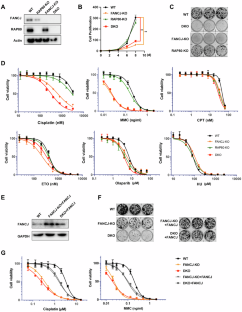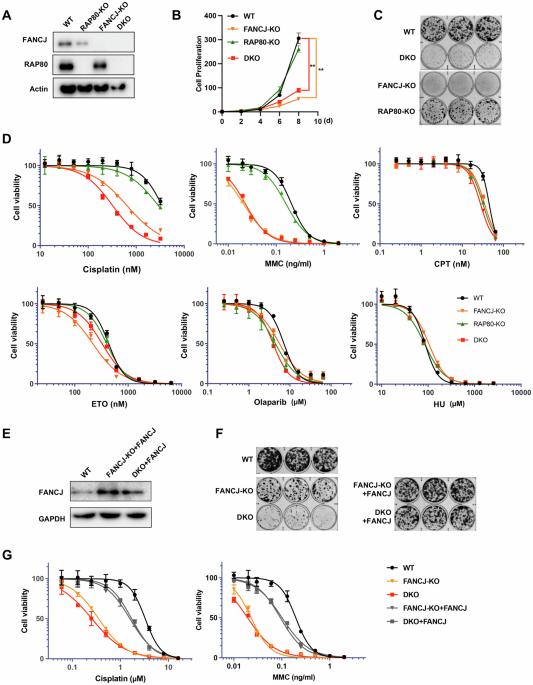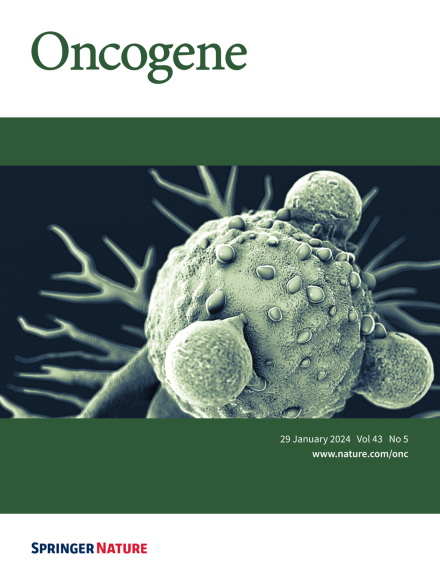Systematic investigation of BRCA1-A, -B, and -C complexes and their functions in DNA damage response and DNA repair
IF 6.9
1区 医学
Q1 BIOCHEMISTRY & MOLECULAR BIOLOGY
引用次数: 0
Abstract
BRCA1, a breast cancer susceptibility gene, has emerged as a central mediator that brings together multiple signaling complexes in response to DNA damage. The A, B, and C complexes of BRCA1, which are formed based on their phosphorylation-dependent interactions with the BRCA1-C-terminal domains, contribute to the roles of BRCA1 in DNA repair and cell cycle checkpoint control. However, their functions in DNA damage response remain to be fully appreciated. Specifically, there has been no systematic investigation of the roles of BRCA1-A, -B, and -C complexes in the regulation of BRCA1 localization and functions, in part because of cellular lethality associated with loss of CtIP protein, which is an essential component in BRCA1-C complex. To systematically investigate the functions of these complexes in DNA damage response, we depleted a key component in each of these complexes. We used the degradation tag system to inducibly deplete endogenous CtIP and obtained a series of RAP80/FANCJ/CtIP single-, double-, and triple-knockout cells. We showed that loss of BRCA1-B/FANCJ and BRCA1-C/CtIP, but not BRCA1-A/RAP80, resulted in reduced cell proliferation and increased sensitivity to DNA damage. BRCA1-C/CtIP and BRCA1-A/RAP80 were involved in BRCA1 recruitment to sites of DNA damage. However, BRCA1-A/RAP80 was not essential for damage-induced BRCA1 localization. Instead, RAP80/H2AX and CtIP have redundant roles in BRCA1 recruitment. Altogether, our systematic analysis uncovers functional differences between BRCA1-A, -B, and -C complexes and provides new insights into the roles of these BRCA1-associated protein complexes in DNA damage response and DNA repair.


系统研究 BRCA1-A、-B 和 -C 复合物及其在 DNA 损伤反应和 DNA 修复中的功能
BRCA1 是一种乳腺癌易感基因,它已成为一种中心介质,能在 DNA 损伤时汇集多种信号复合体。BRCA1 的 A、B 和 C 复合物是在与 BRCA1-C 端结构域的磷酸化依赖性相互作用的基础上形成的,它们有助于 BRCA1 在 DNA 修复和细胞周期检查点控制中发挥作用。然而,它们在 DNA 损伤反应中的功能仍有待充分认识。具体来说,BRCA1-A、-B 和 -C 复合物在调控 BRCA1 定位和功能方面的作用还没有系统的研究,部分原因是 CtIP 蛋白是 BRCA1-C 复合物中的一个重要组成部分,而 CtIP 蛋白的缺失会导致细胞死亡。为了系统地研究这些复合体在 DNA 损伤应答中的功能,我们耗尽了每个复合体中的一个关键组分。我们使用降解标签系统诱导性地去除内源性 CtIP,并获得了一系列 RAP80/FANCJ/CtIP 单、双、三基因敲除细胞。我们发现,BRCA1-B/FANCJ 和 BRCA1-C/CtIP 的缺失会导致细胞增殖能力降低,对 DNA 损伤的敏感性增加,而 BRCA1-A/RAP80 则不会。BRCA1-C/CtIP 和 BRCA1-A/RAP80 参与了 BRCA1 招募到 DNA 损伤位点的过程。然而,BRCA1-A/RAP80 对损伤诱导的 BRCA1 定位并不重要。相反,RAP80/H2AX 和 CtIP 在 BRCA1 招募过程中起着多余的作用。总之,我们的系统分析揭示了 BRCA1-A、-B 和 -C 复合物之间的功能差异,并对这些 BRCA1 相关蛋白复合物在 DNA 损伤应答和 DNA 修复中的作用提供了新的见解。
本文章由计算机程序翻译,如有差异,请以英文原文为准。
求助全文
约1分钟内获得全文
求助全文
来源期刊

Oncogene
医学-生化与分子生物学
CiteScore
15.30
自引率
1.20%
发文量
404
审稿时长
1 months
期刊介绍:
Oncogene is dedicated to advancing our understanding of cancer processes through the publication of exceptional research. The journal seeks to disseminate work that challenges conventional theories and contributes to establishing new paradigms in the etio-pathogenesis, diagnosis, treatment, or prevention of cancers. Emphasis is placed on research shedding light on processes driving metastatic spread and providing crucial insights into cancer biology beyond existing knowledge.
Areas covered include the cellular and molecular biology of cancer, resistance to cancer therapies, and the development of improved approaches to enhance survival. Oncogene spans the spectrum of cancer biology, from fundamental and theoretical work to translational, applied, and clinical research, including early and late Phase clinical trials, particularly those with biologic and translational endpoints.
文献相关原料
| 公司名称 | 产品信息 | 采购帮参考价格 |
|---|
 求助内容:
求助内容: 应助结果提醒方式:
应助结果提醒方式:


